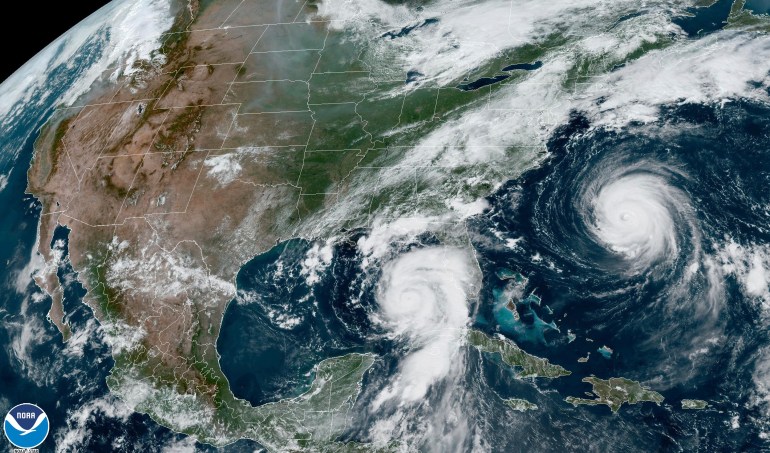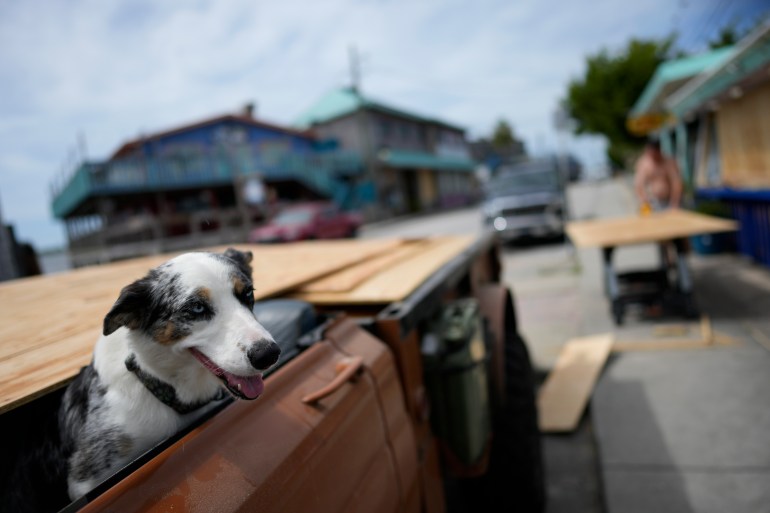Florida braces for Hurricane Idalia as storm builds over warm Gulf waters | Weather News

[ad_1]
It is a quiet part of the Florida coast, known for sport fishing, clam farming and wooden houses on stilts, perched right on the water.
But the small island of Cedar Key, Florida, is among the coastal communities expected to face the brunt of Hurricane Idalia, which strengthened into a Category 2 storm on Tuesday afternoon.
Idalia is projected to make landfall in the United States during the early hours of Wednesday. Meteorologists predict it will strike as a Category 3 cyclone on the five-tier wind scale, passing the threshold for what is considered a “major” hurricane.
“This is a life threatening situation,” the National Hurricane Center warned in a bulletin Tuesday afternoon.
The centre predicted storm surge up to 4.6 metres high (15 feet) along the stretch of coastline from the Aucilla River down to Yankeetown, an area that includes Cedar Key and quaint destinations like the scallop-harvesting town of Steinhatchee.
“That is storm surge that — if you’re there while that hits — it’s going to be very difficult to survive that, so please take appropriate precautions,” Florida Governor Ron DeSantis told reporters from the state capital in Tallahassee.
“This is crunch time right now. We’re going to get hit with a major hurricane,” he added.

A total of 28 counties have issued evacuation orders, as Idalia approaches the “Big Bend” region of the state, a curve where the Florida peninsula connects to the mainland.
School districts across Florida have cancelled their classes, as well as 18 state colleges and six universities, including major institutions like the University of Florida in Gainesville and Florida State University in Tallahassee.
The storm is expected to barrel across the state, ploughing from the Gulf of Mexico across land to the Atlantic Ocean as it travels northeast towards Georgia and the Carolinas.
“Idalia is likely to still be a hurricane while moving across southern Georgia, and possibly when it reaches the coast of Georgia or southern South Carolina on Wednesday,” the hurricane centre said.
Ocean temperatures around Florida have reached unprecedented levels in recent months, with the water’s surface becoming as hot as 38 degrees Celsius (101 degrees Fahrenheit) in July.
That, in turn, has allowed Idalia to intensify rapidly, as heat spirals up from the water and moisture fills the air.

Parts of Florida are still recovering from another powerful storm, Hurricane Ian, which slammed the state as a Category 4 cyclone in 2022.
An estimated 150 people died as Ian tore through the west coast of Florida, leaving over $112 billion in damage — the costliest hurricane ever to ravage the state.
Idalia, meanwhile, is set to strike just north of where Ian did, in an area that has not experienced any major hurricane in recent history.
“Particularly in this part of the state, you’ve really got to go back to the late 1800s to find a storm of this magnitude that will enter where this one looks like it’s going to enter tomorrow,” DeSantis told reporters on Tuesday. “We don’t really have a historical analog in anybody’s memory, so it’s like to cause a lot of damage, and that’s just the reality.”
That lack of experience has local officials worried about complacency. Mayor Heath Davis of Cedar Key estimated that 100 residents planned to ride out the storm — out of a community that typically numbers around 800 people on the small barrier island.
“This is bad. At the least, it’s worse than we’ve ever seen,” Davis said at a Tuesday press conference. “If you live in an area and you’ve been there a long time and you think that just because you’ve never had a bad situation there before, it’s going to be worse.”
With bridges to areas like Cedar Key scheduled to close in anticipation of the high winds, officials warned residents to take local evacuation orders seriously.
“If you have not evacuated, you need to do that right now,” Kevin Guthrie, director of the Florida Division of Emergency Management, said. “You need to drop what you’re doing. You need to go to your room, pack up, pack your things and get to safety.”
[ad_2]



